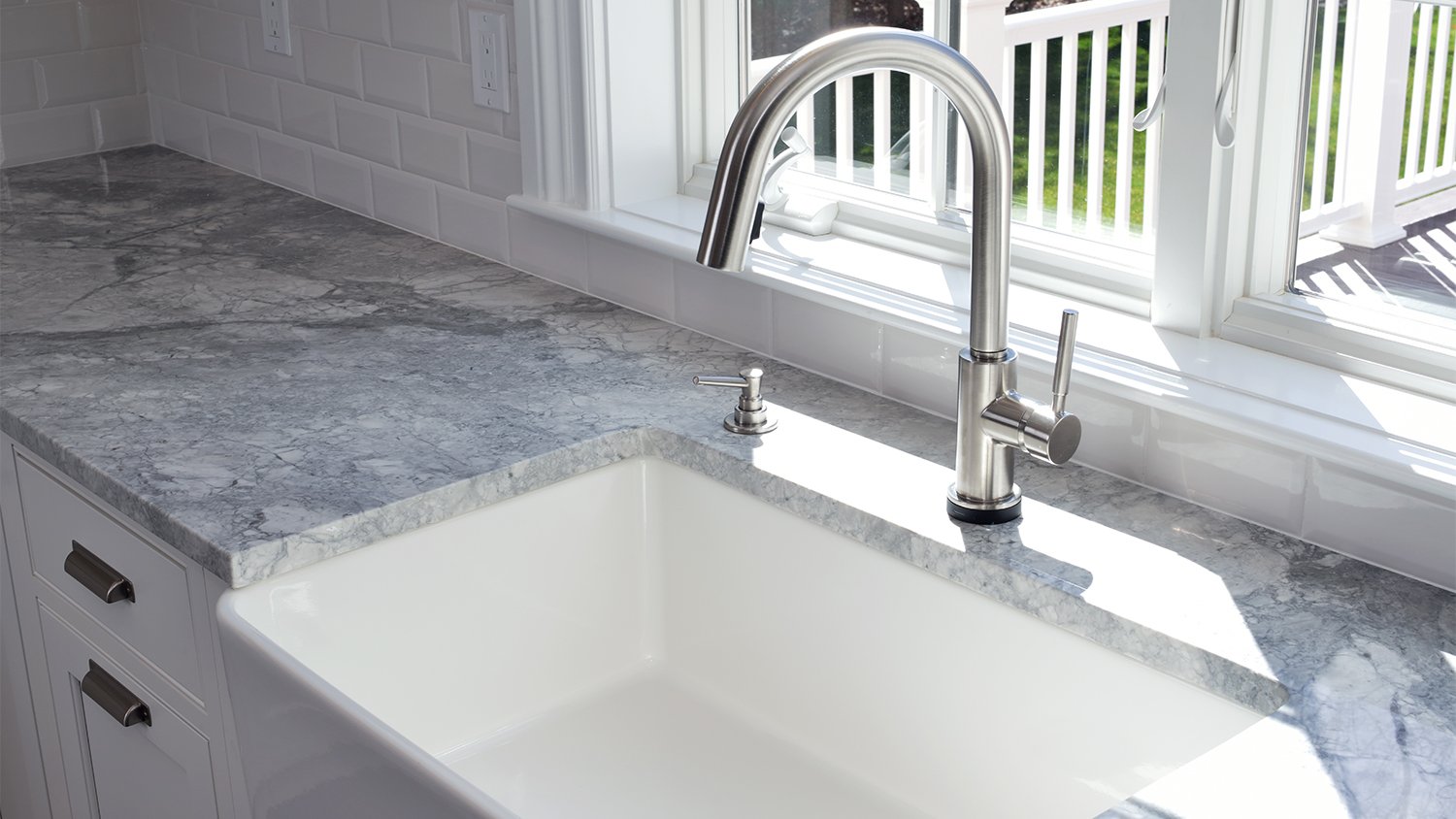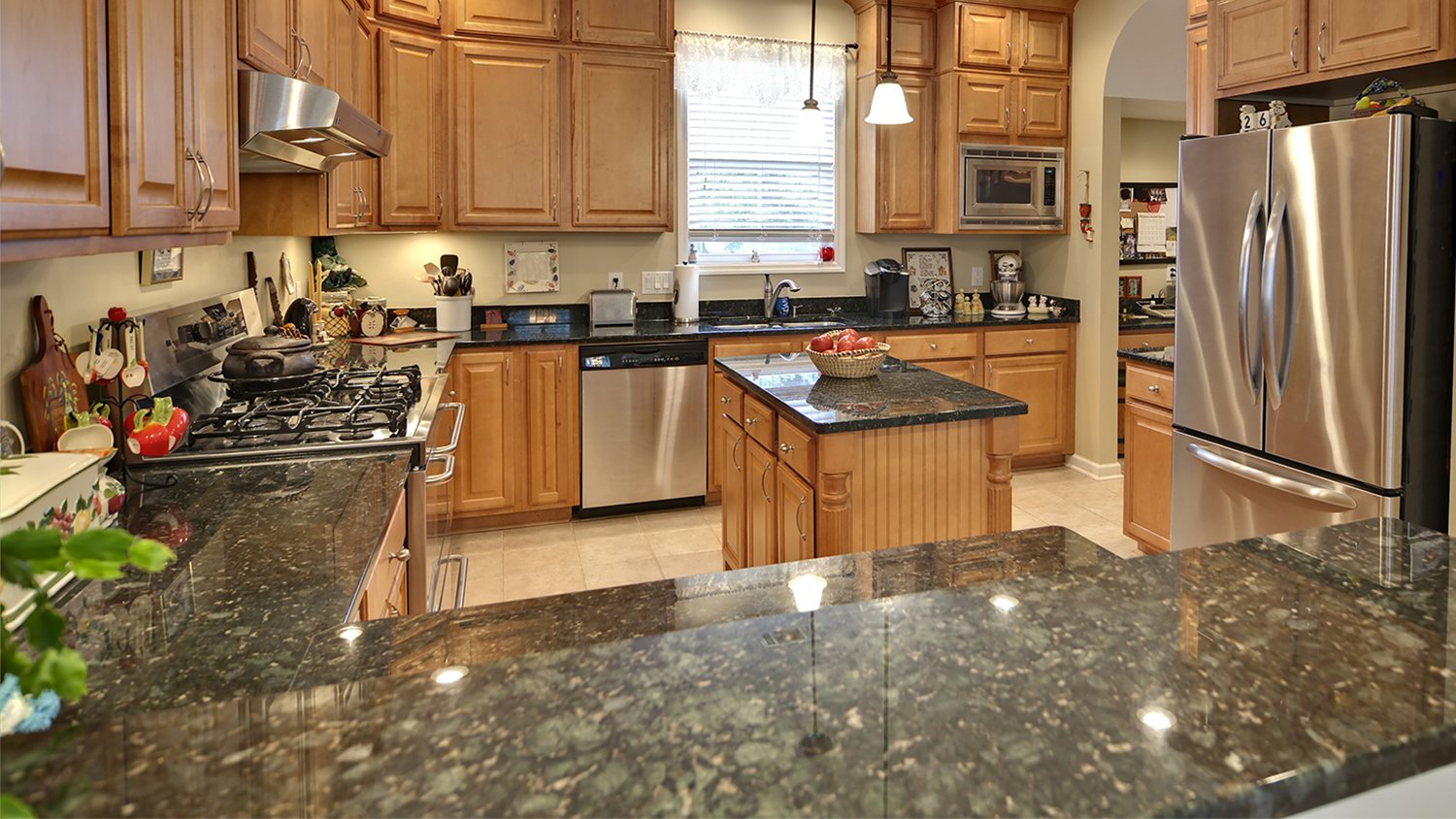
Granite counters are durable and stylish, but if you’re wondering how much granite countertops cost, it’s time to dig into the details.
If you are looking for a gorgeous stone kitchen countertop, here are our recommendations
Natural stone is a popular countertop material, thanks to its visual appeal and inherent durability, but what is the best stone for kitchen countertops and islands? Showstopping varieties like granite and marble are steadfast classics, but different types of stone countertops have their pros and cons. A trendy option like slate or engineered stone (which still contains some natural materials) may be a better fit. This guide will help you weigh your options.

Highly regarded for its coloring and veining, granite’s timeless appeal can elevate a kitchen’s style and presence. This material offers high levels of durability to resist damage from scratches, blows, cracks, and other kitchen incidents that constitute the normal wear and tear that any residential kitchen countertop will undergo over the years.
Like most natural stones, granite countertops are an investment compared to materials like laminate. Granite remnants are a more affordable option and work well for smaller projects. Another potential drawback to granite is its natural porousness. Fortunately, that is a relatively simple problem to solve with a bit of sealant; granite will not absorb liquids if properly sealed. Over time, sealant wears off, so be sure to seal your granite counters as needed. Keeping up with the resealing schedule is crucial to maintaining the condition and appearance of your granite countertops.
Granite countertops are a classic for a reason. They are a solid option at a reasonable price point for natural stone. That said, they still do have some drawbacks.
| Pros | Cons |
|---|---|
| High durability | Limited design choices |
| Unique appearance | Limited repair options |
| Heat resistant | Requires annual sealing |
| More stain resistant than other natural stones | Acidic substances can damage surface |

Often associated with the height of elegance and status, marble slabs make great stone kitchen islands. They are favored by bakers and pastry chefs, who appreciate the cold, smooth stone when rolling out dough. While marble countertops are heat resistant, they are not as hardy when handling hot pots and pans. This material is soft and porous, making cleaning your countertop a challenge if errant liquids and substances seep in. Always use trivets, and seal your countertop every six months.
While marble is not the best budget-friendly kitchen countertop idea, many homeowners find this stone to be worth the splurge. Here are some pros and cons.
| Pros | Cons |
|---|---|
| Luxurious look with many design options | Costs more than other stones |
| Each stone has unique veining | Not completely heat resistant |
| Long lifespan and relatively high durability | Requires regular resealing due to porosity |
| Adds value to your home | Can etch and scratch |
Limestone is known for lovely earth tones ranging from light beige to a toasty brown. Because it contains calcium minerals, it is susceptible to damage due to stone etching or dull spots caused by acidic substances spilling on the surface.
This stone is not quite as resistant to hot temperatures as others, so it requires more care to keep it looking its best. If you happen to damage your limestone countertop by setting a hot pan on it, you can get it repaired, but that cost may add up if you are not consistently careful when cooking.
Limestone resists UV light and weather reasonably well, so it is one of the best stone kitchen countertops for outdoor use. If you are comfortable giving it the care and attention it needs to stay looking sharp, a limestone countertop can deliver what you are looking for, inside or out.
Limestone has a classic look that channels the rustic feeling of the English countryside. Nonetheless, it is not right for every kitchen.
| Pros | Cons |
|---|---|
| Budget friendly | Susceptible to scratches |
| Classic, rustic look | Acidic substances can etch surface |
| Resists bacteria and mold | Prone to stains due to porosity |
| Satin (but not glossy) finish feels unique | Only moderately heat resistant |

With its shale and clay components, slate offers an elegant gloss with a nonporous surface that resists damage from heat and moisture. The main part of a slate countertop is resistant to chips and scratches and works well for indoor and outdoor kitchen countertops. It is even antibacterial and resistant to mildew or mold.
On the other hand, slate countertops can come with corners that must be treated with care to avoid chipping or cracking. The quality of slate can vary quite a bit, depending on its source. You may also be disappointed with a more limited set of color options.
Slate is one of the trendiest types of countertops. It is right up there with butcher block and concrete. Is it worth it? You will have to weigh the pros and cons of slate countertops.
| Pros | Cons |
|---|---|
| Elegant look | Edges prone to cracking |
| Mold resistant and antibacterial | High cost |
| Good for indoor and outdoor use | Limited color options |
| Heat resistant | Can be difficult to work with |

Soapstone can bring a homey feel to your kitchen. The talc content lends a creamy texture, so it is a preferred choice for homes with a modern farmhouse or Americana design aesthetic. Many counters come in shades of cream or white, but you can find beautifully veined slabs in other colors, such as brown, blue, green, and more. Rarer soapstone costs more than readily available varieties.
Soapstone does require more care and regular applications of mineral oil to help bring out its best patina (or visual gloss) over time. It is only slightly less scratch resistant than granite, but that makes it more pliable and less likely to crack from weight stresses. Soapstone is highly resistant to moisture and heat damage and is easy to clean, making it one of the best countertop materials. To clean, use a mild soap and water solution and dry with a clean rag.
Soapstone is one of the most durable types of stone countertop materials, but not everyone likes the creamy look. Here are some pros and cons to consider.
| Pros | Cons |
|---|---|
| One of the most durable natural stones | High upfront costs |
| Nonporous | Susceptible to scratches |
| Easy to clean | Limited colors and options |
| Heat resistant | Oil can cause dark spots |
| Easy to install compared to other stones | Requires regular oiling |

Travertine, a type of limestone, does not have to go through extensive processing before it is cut and polished for countertops, making it more eco-friendly. Furthermore, you can find travertine in various colors, from white and cream to light tan and earthy browns.
Travertine is somewhat susceptible to hard water and organic substance staining, especially from acidic liquids and foods, such as oranges or lemon juice. Wipe up stains from citrus and other acidic substances immediately to avoid etching. Thankfully, it is easy to clean this stone countertop material with gentle cleaners made specially for travertine or phosphate-free dish detergent.
This limestone kitchen countertop offers a unique look, but you may want to think twice if you are a messy cook. Let’s look at the pros and cons.
| Pros | Cons |
|---|---|
| Affordable | Vulnerable to acidic liquids and hard water |
| Light color can brighten a space | Not as heat resistant as other stones |
| Easier to cut and customize than other stones | Not as durable as other countertop materials |
| Range of options from mosaic tiles to slab | Requires regular sealing due to porosity |

Solid surface countertops are not pure stone, but they contain minerals and can mimic the look of stone. They mainly consist of natural minerals in synthetic polyester or acrylic resin with added substances for color. That means you can have a seamless look for a relatively lower price.
That said, the price is not always the best value if you choose a name brand. For example, Corian (TM) countertops cost an average of $4,000, which is more than the average granite countertop. Solid surface does, however, come with high durability, water resistance, and scratch resistance. Keep in mind that they are susceptible to damage from UV rays, so you will want to restrict them to inside use.
This type of engineered surface can actually be more durable than natural stone because it is mixed with resins. That said, it does still have some drawbacks.
| Pros | Cons |
|---|---|
| Higher durability than natural stone | Not heat resistant, can scorch |
| Water and stain resistant by design | Vulnerable to UV damage |
| Extremely low maintenance | Difficult to DIY |
| Typically more affordable than natural stone | Can have less resale value than natural stone |

Onyx brings an ethereal sense of translucence to a kitchen and suits both rustic and ultra-contemporary looks. Maintenance and care could not be easier; all you need is a mild soap and water solution and a soft cloth for drying and wiping it down.
You should be aware, however, that onyx is one of the most fragile types of stone countertops on this list. For that reason, you may want to steer clear of it for your kitchen countertops, which will sustain regular wear and tear over the years. Alternatively, it could perform beautifully in your bathrooms.
The average cost of countertop installation is $3,100, although the range a household might pay can be anywhere from $1,840 to $4,385. Numerous factors go into the installation cost, namely the material, type, and size. Ceramic and laminate are some of the least expensive materials, but marble countertops can reach prices of $190 per square foot.
While you can install a countertop as a DIY project and save significantly, it’s not advised. Some countertop manufacturers only honor its warranty if it’s installed by a local countertop professional. Additionally, installing countertops requires technical skills, and the weight of a countertop makes it even more difficult. You could damage the countertop during the installation process, which can wreak havoc on a budget.
Sara Coleman contributed to this article.
From average costs to expert advice, get all the answers you need to get your job done.

Granite counters are durable and stylish, but if you’re wondering how much granite countertops cost, it’s time to dig into the details.

The cost of stainless steel countertops may seem shocking compared to laminate, but their durability may be worth it. Here’s how much you can expect to spend.

Explore how much concrete countertops cost to install based on factors like their size, thickness, location, finish, and labor rates.

Granite countertops need a sealant to prevent staining and other lasting damage. Learn how to seal granite countertops to keep them in great shape for longer.

Installing countertops is grueling work, so leaving a tip for your countertop installers is always an appreciated gesture—but how much depends on the quality of work.

A kitchen countertop can provide extra space to sit, eat, and socialize. This guide explains how much countertop overhang is needed for seating.